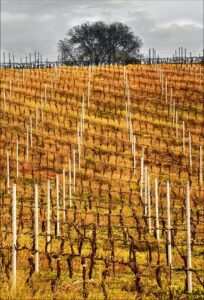The Basilicata wine region may not be the most famous Italian wine region, despite the fact that wine has cultivated here since the ancient Greek times. Basilicata is located between 2 other and probably more famous wine region which are Puglia to the east and Campania in the West. The presence of the Greeks has still today left their traces in Basilicata since they contributed to the introduction of various grapes varieties and they also introduced the so called “Alberello”-plantations which are common in Sicily.

The Basilicata wine region has in recent years, like many other wine regions, undergone major structural changes. Mass wine making has in some extention been replaced by quality thinking. Less wine and less number of wineries produce today better quality than a few decades ago. Best known is perhaps the “DOC Aglianico del Vulture” which is produced in 15 municipalities around the “Vulture” volcano in the northeastern part of Basilicata. Vulture has seven peaks which reach 1300 meters above the sea around the Monticchio lake. Here are mainly cultivated olives, chestnuts and Aglianico grapes. The Aglianico has Greek origin and was first called Ellenico. The name has since developed into the first Ellanico, Allanico and later to Aglianico after the Spanish domination in southern Italy. Aglianico is cultivated in potassium-rich soil, preferably between 200-500 meters above sea level. The harvest is late, often in the second half of October. What characterizes the Aglianico del Vulture is the ruby red color, a pleasant and distinctive aroma, high concentration and alcohol strength and present tannins which together provide powerful wines with personality and which distinguish from other Aglianico wines in the southern Italy.Since 2010 there is also the DOCG wine “Aglianico del Vulture Superiore”. The difference to the usual Aglianico del Vulture is that this wine will be released only the third year after harvest, after 1 year’s storage in oak barrels and then another 1 year in the bottle. There is also the “Aglianico del Vulture Riserva” which means that the wine is aged 2 years in oak barrels and then one year in the bottle before being released.
However, in Basilicata there is not only Aglianico del Vulture. You will also find “DOC Terre dell ‘Alta Val d’Agri” which is only produced in the municipalities of Viggiano, Moliterno and Nova Grumentum in the province of Potenza. The vineyards are situated at 650 to 800 meters above sea level. Wine has been grown here along the river Agri since the Roman times and Malvasia Bianca di Basilicata, Malvasia nera di Basilicata and Moscato bianco di Basilicata grow here along with the more international Cabernet Sauvignon and Merlot.
Further south along the Agri Valley on the border of the Pollino National Park, we find the municipalities Roccanova, Castro Nuovo di Sant’Andrea and Santarcangelo where the IGT-wine Grottino is produced. Grottino is produced and stored in the cave sites excavated in the sandstone and is located in the center of Roccanova, hence the wine’s name “Grottino”. IGT “Grottino Rocca Nova” are both white, red and rosé grown in one of the mentioned municipalities. The most common grape varieties used are Sangiovese, Malvasia Bianca di Basilicata, Malvasia nera di Basilicata and Moscato bianco di Basilicata.
In the Eastern part of Basilicata we’ll find the, from tradition and history, specific area called Materane-hills. Wine grow here since ancient Greece and it was the Greeks who started the plantation of new grape varieties and established new cultivation techniques. The landscape varies from mountain (500 meters above sea level) in Tricarico, Matera and Grottole to coastal land (100-150 meters above sea level) overlooking the Ionian Sea. This is where we find the DOC Matera wines which have become DOC as recently as 2005 and is available in 6 different versions; DOC Matera Rosso , DOC Matera Primitivo, DOC Matera Moro, DOC Matera Greco, DOC Matera Bianco, DOC Matera Spumante. Sangiovese and Primitivo are the most common varieties for the red wines. Other cultivated varieties are Montepulciano, Merlot and Cabernet and for the white wines, Malvasia Bianca di Basilicata and Greco.The most widely planted grape variety is Primitivo di Matera which is harvested early, in late August and early September. The wine made from these grapes is very colorful, full-bodied with high alcohol strength. Other cultivated grape varieties are Sangiovese, Montepulciano, Merlot and Cabernet Sauvignon and among the white you’ll find the Malvasia Bianca di Basilicata and the Greco.
In addition to these specific DOC wines, we also find the more generic IGT Basilicata wines which are produced in both white-, red- and rosé in the two provinces of Potenza and Matera.


